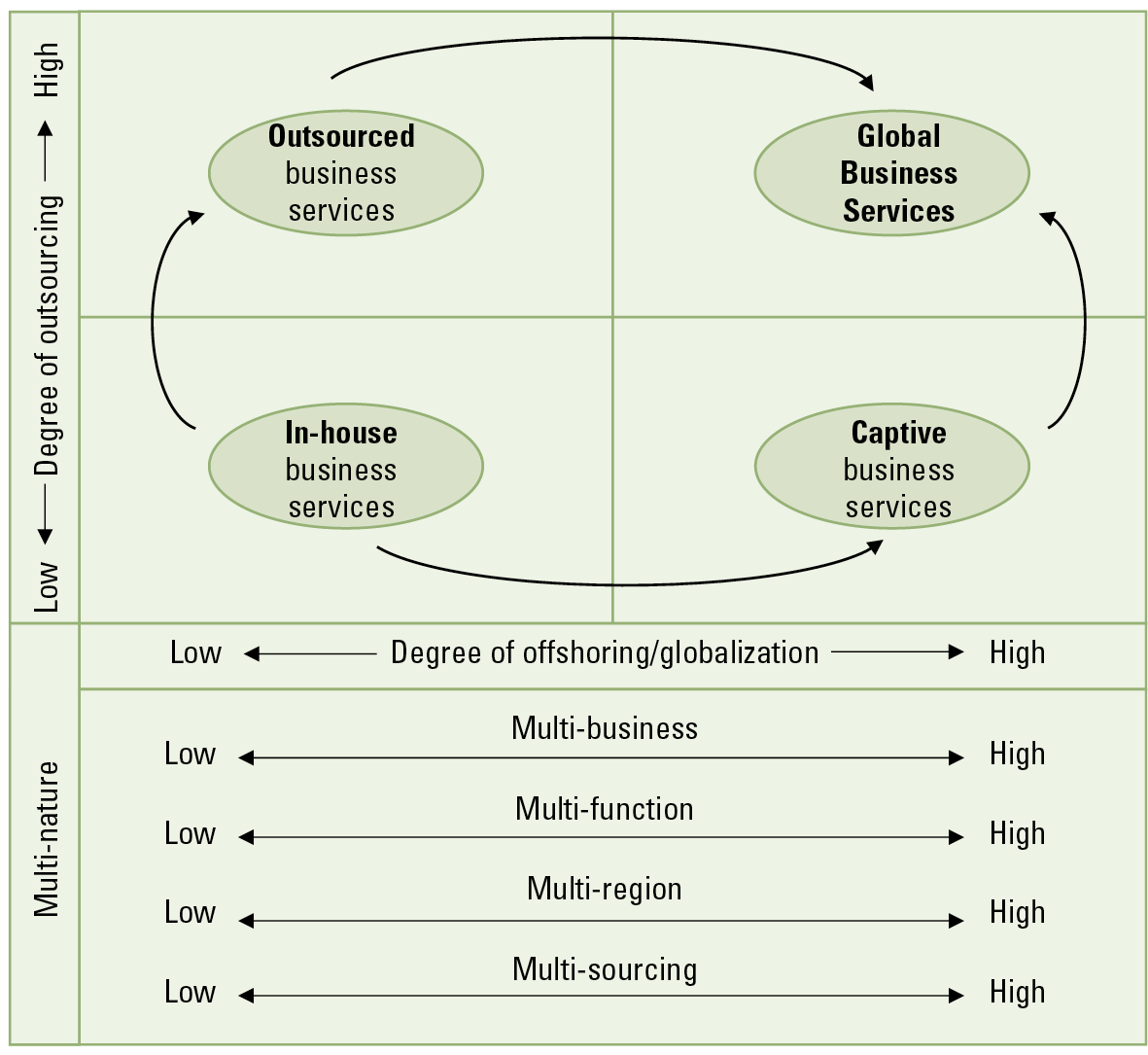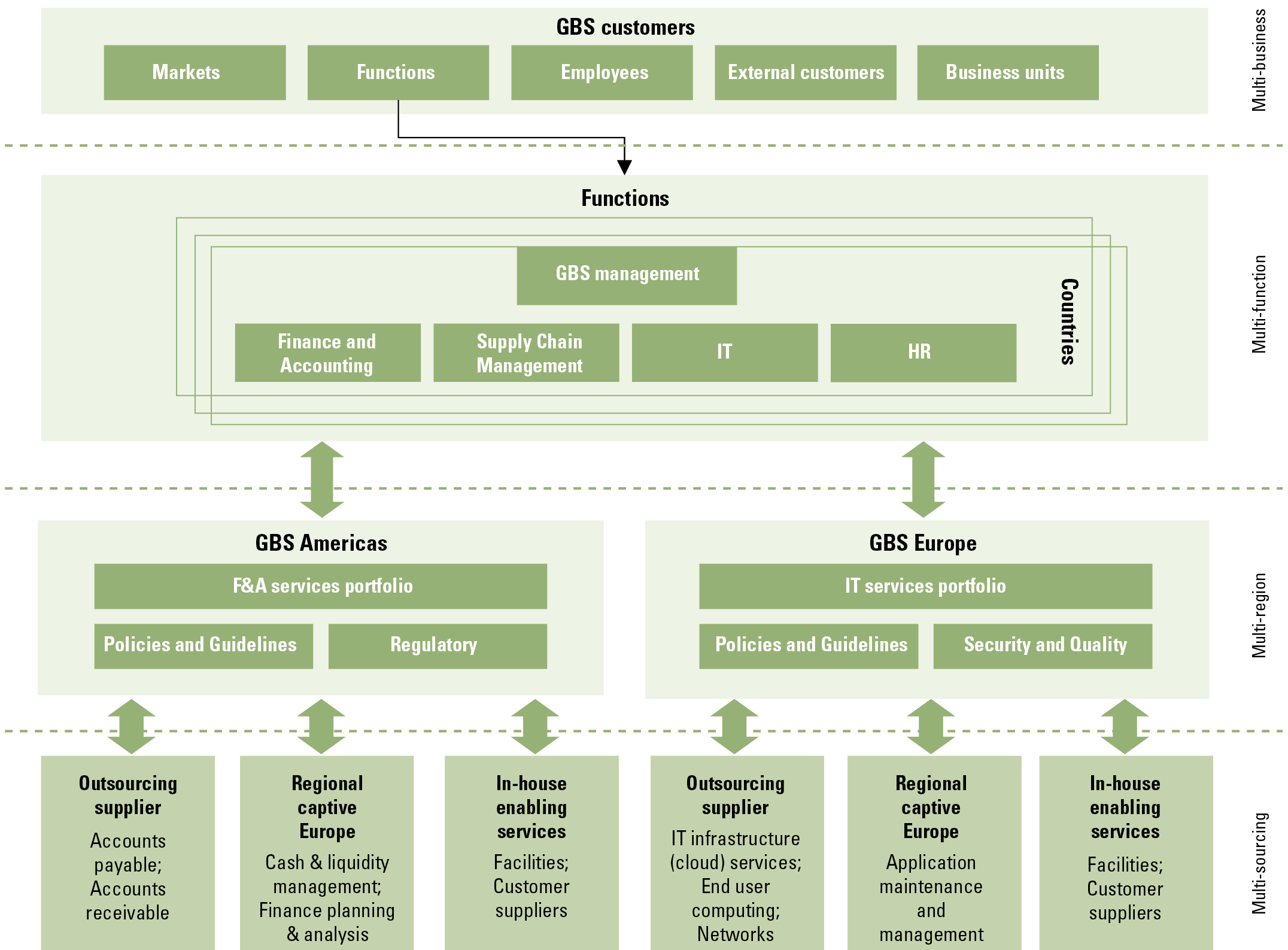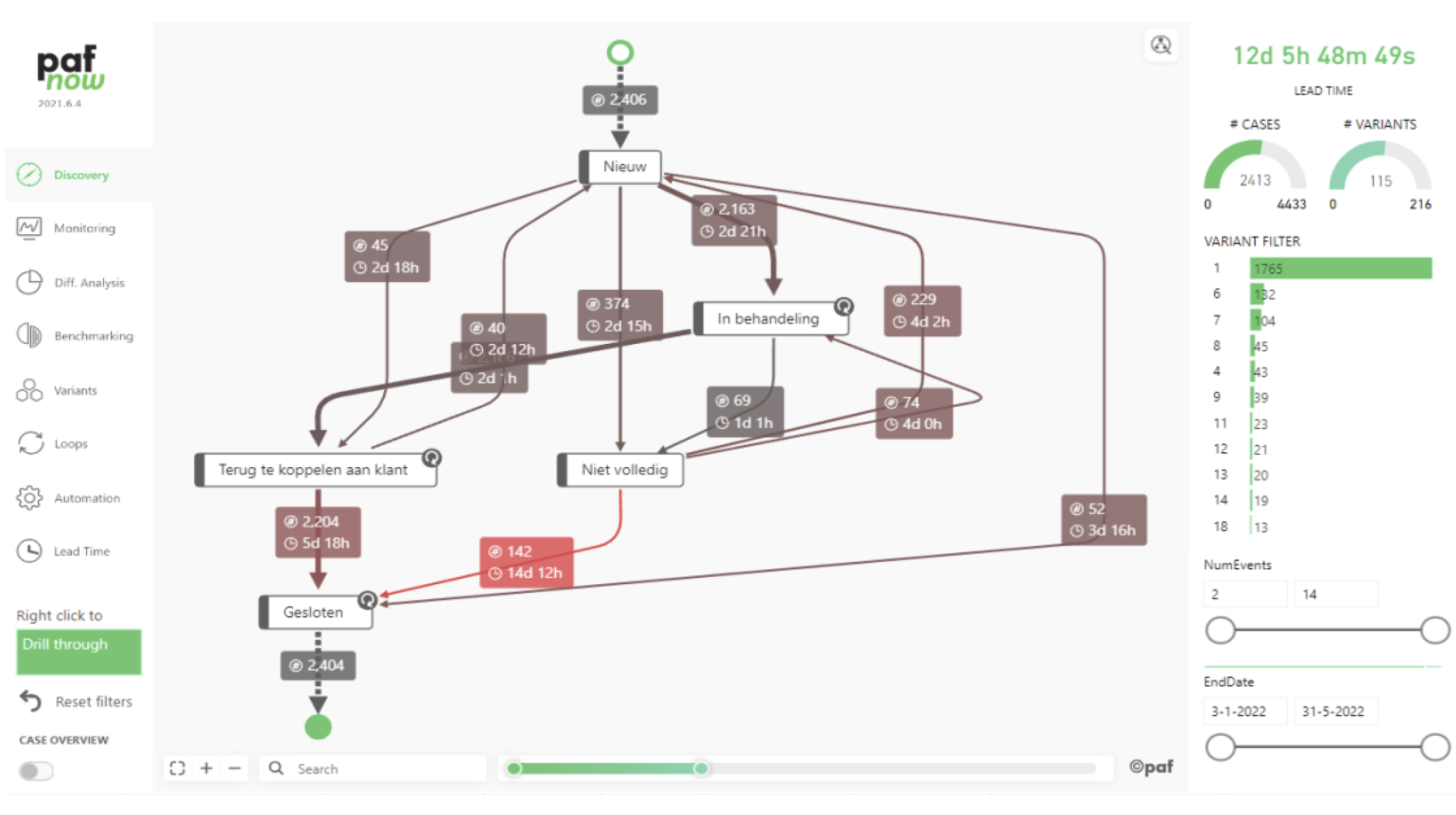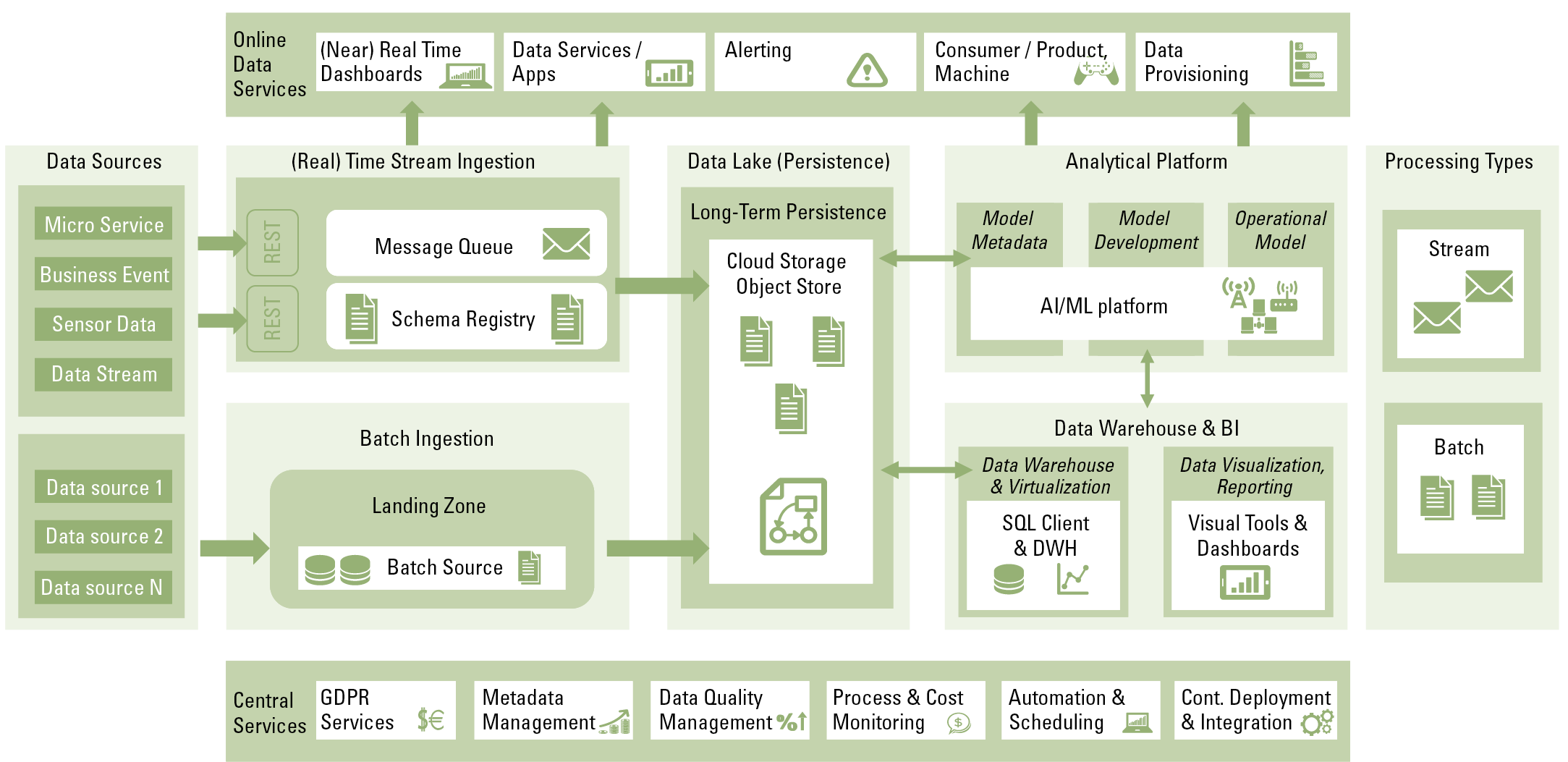Acting in a dynamic market, organizations experience global competition, face Environmental, Social, and Governance (ESG) requirements, they must keep pace with rapid technological developments, and be resilient to handle geopolitical turbulence. To maintain their competitive position in the market, organizations use Global Business Services (GBS), which includes Shared Service Centers (SSC), to respond to customer demands adequately. GBS is considered to be a complex model, and various factors need to be orchestrated continuously to ensure proposed benefits. However, it is unknown which factors affect the implementation of GBS from a holistic perspective. Importantly, it is assumed that digital technologies may overcome GBS implementation challenges. Based on an international study, the authors identified six factors that form a part of an organization’s GBS orchestration capability, namely: plural sourcing strategy, business services portfolio, customer orientation, modularized business processes, information technology (standardization) and governance (decision rights). In addition, we find that various digital technologies are applied that overcome GBS implementation challenges. Our findings contribute to the effective implementation of GBS by practitioners.
Introduction
The degree in which organizations have to compete today in a globalized market cannot be compared with primarily scale-based competition of the previous century. Acting in a dynamic market, organizations experience global competition, face Environmental, Social, and Governance (ESG) requirements, they must keep pace with rapid technological developments, and be resilient to handle geopolitical turbulence. To maintain their competitive position in the market, organizations use Global Business Services (GBS) to respond to customer demands adequately. The four most common GBS functions include:
- Finance & Accounting (F&A)
- Human Resources (HR)
- Information Technology (IT), and
- Supply Chain Management (SCM).
Originally, GBS is positioned as back-office services to support employees within an organization in fulfilling their tasks. As an increasing number of functions and corresponding processes of an organization become digitalized, GBS relies on various sources of digital data. Due to the rise of digitalization, external customers raise demands that impact GBS directly. To deal with customer demands directly, organizations are transforming their business services into a hybrid mode, or in other words, modern GBS. However, GBS implementation success stories are relatively scarce and predominantly based on stand-alone case studies, and as such due to their multifaceted nature, organizations struggle to implement business services effectively.
Importantly, the factors that affect a GBS implementation have rarely been studied from a holistic perspective ([Plug24b]). Consequently, organizations lack insight into the factors that contribute to a successful GSB implementation. Although digitalization’s impact on businesses and organizations is widely acknowledged, its effects have not yet been studied within the specific context of a GBS implementation. Therefore, the objective of this study is to identify the factors that form part of an organization’s orchestration capability aimed at implementing GBS. We also aim to demonstrate how digitalization may overcome business services implementation challenges.
Global Business Services
Originally, GBS was established within organizations with a focus on sustaining their internal organization rather than providing business services to end users (consumers or other businesses). GBS is defined as “services that are provided both in-house and to other businesses and can be characterized by their knowledge-intensive nature” ([Wirt15]). The evolution of business services and corresponding delivery models includes Shared Service Centers (SSC), outsourcing, offshoring, and captive centers. GBS consists of a variety of services such as, F&A, Administration, HR, SCM, Procurement, Legal, and IT ([Plug24a]). The emergence of GBS can be linked to the impacts of the financial crisis of 2007–2008 on businesses. This severe worldwide economic crisis forced organizations to focus on cost reduction, lower their quality of services, and consequently change their operating model. A recent market study conducted by BCG ([BCG22]) shows that the concept of GBS matured over time and currently there are more than 10.000 GBS centers around the world. BCG projected the growth of the GBS market from USD 1.8 trillion in 2022 to USD 2.5 trillion USD by 2025. GBS models can be characterized by their “multi-nature” ([KPMG19]), namely: multi-business (e.g. support various business departments), multi-function (e.g. support various services like F&A and HR), multi-region (e.g. various geographies), and multi-sourcing (e.g. both in-house and outsourced) approach. The most mature organizations focus on which types of business services are supported in-house or outsourced, while associated delivery units focus on how business services are provided, supporting the multifaceted nature of GBS. The evolution of business services and their corresponding delivery models over time is depicted in Figure 1.
Figure 1. Evolution of Business Services (adapted from [Wirt15]). [Click on the image for a larger image]
Implementation challenges
Due to its multifaceted nature, GBS is a complex model, and various aspects across different geographies and business departments need to be aligned and orchestrated continuously to ensure the proposed benefits. Prior studies have explored the factors contributing to the success of GBS implementation. However, success stories are relatively scarce and predominantly based on stand-alone case studies. In studying the GBS literature, we can categorize implementation challenges into four primary groups:
- strategy & organization
- operating & delivery model
- business processes, and
- geography.
From an organization perspective, tensions were found on how to implement a GBS strategy such as a big-bang scenario or a more gradual implementation strategy (step-by-step approach) of business services. In addition, unclarity about organizational boundaries may hinder the provisioning of business services, which are provided by internal and or external suppliers. Addressing operating and delivery challenges, organization management must invest in additional governance and orchestration, or in other words coordination, towards external suppliers to continue service provisioning, mitigating business and operational risks and ensure compliance.
The challenge of business processes, however, arises from the fact that there is no one-size-fits-all solution. Business processes are context-dependent, meaning they must be adapted to various aspects, such as an organization’s industry, its role within that industry, and the specific underlying processes and services of the organization. Finally, geography plays an essential role when implementing business services ([Oshr23]). Cultural differences, which reflect the extent of variation between an organization and its suppliers across one or more cultural dimensions, play a critical role. Greater cultural distance can negatively impact the outcomes of business services.
Figure 2 shows an example of the GBS multi-function characteristics and corresponding delivery models (multi-sourcing) in a geographic dispersed view (multi-region) that may support various businesses (multi-business).
Figure 2. Example of a GBS structure (authors). [Click on the image for a larger image]
Research approach
To gain insight into the factors that affect the implementation of GBS, we distributed a survey to 121 globally operating organizations that implement GBS. As a next step, to examine how digitalization influences the implementation of GBS factors, we conducted four case studies in globally operating organizations across various industries, including: Logistic Services provider, Building and Construction organization, Employment Agency, and a Financial Services provider. We collected and analyzed the data between January 2018 and February 2024, interviewed 16 participants in total and studied numerous documents.
Factors that affect GBS implementation
Our study offers several influential insights. First, we identified six factors that impact the implementation of GBS: plural sourcing strategy, business services portfolio, customer orientation, modularized business processes, information technology (standardization), governance (decision rights). We find that all GBS functions (e.g. F&A, HR, IT, SCM) rely significantly on a plural sourcing strategy (make and buy). Applying a plural sourcing strategy, we noticed a variety of benefits, such as enhanced supplier competition, a lower risk of supply chain interruption, and increased flexibility in responding to changing market conditions. We also find challenges such as coordinating delivery, managing multiple suppliers, and ensuring constant quality. Organizational controls can help mitigate these challenges. Specifically, outcome-based controls are effective for governing internal suppliers, while behavioral controls (e.g. proactive behavior, integrity) are more suitable for managing external suppliers.
The business services portfolio has emerged as a critical factor, acting as “the spider in the web” during GBS implementations. This requires managers to possess the skills necessary to structure and manage an organization’s portfolio of resources. As such, a business services portfolio should be viewed as an instrument that demands intensive management attention to orchestrate the allocation and deployment of both internal and external business services (plural sourcing) in a flexible manner. Thus, management’s proficiency in orchestrating a business services portfolio enhances the overall performance of an organization by effectively monitoring service delivery and managing the boundaries between the organization and its suppliers.
Our study demonstrates the importance of customer orientation in continuously aligning the demand and supply of internal and external resources in GBS. Organizations must regularly improve their business services and strengthen their knowledge and expertise to deliver higher value to customers and maintain the relevance. Customer orientation entails ensuring that business services meet the needs of internal customers and external customers. To effectively maintain an organization’s business services portfolio, it is essential to regularly verify that the quality of business services (e.g., service levels) aligns with their intended functionality. Consequently, managers must evaluate internal and external customers’ needs and adapt the deployment of in-house and outsourced business services accordingly.
We found that modularized business processes serve as an “interface” between IT standardization and governance, influencing the GBS business services portfolio. To support a business services portfolio that orchestrates both in-house and outsourced business services, organizations are modularizing business processes and unbundling their value chains into independent services. This modularization requires the dynamic coordination of business processes. Management aims to synchronize their business services portfolio through the orchestration of these processes, thereby contributing to overall organizational performance (i.e. service portfolio). By regularly verifying internal and external customers’ needs, organizations can align their portfolio with their business strategy, maximizing the value of their business services portfolio.
In practice, IT systems of organizations support the delivery of business services and have become increasingly integrated, relying on standardized components to cater for business changes effectively. To address evolving customer needs, IT and process standardization is applied to create agility and mitigate the challenges of customization. Managers must coordinate interconnected in-house and outsourced IT systems to support a business services portfolio effectively. Therefore, standardization is not only crucial for modularized business processes but also plays a key role in orchestrating the business services portfolio.
The sixth factor, governance, pertains to the organization’s responsibility for overseeing and managing business services. Managing decision rights should be understood as a dynamic process rather than a fixed set of outcomes, as these rights influence the effectiveness and relevance of various business services. In a plural sourcing context, managing decision rights is crucial for orchestrating a organization’s business services portfolio, which relies on both in-house and outsourced resources. Managers need to verify the decision rights of in-house and outsourced suppliers regularly, as services that require substantial information are increasingly dispersed, potentially affecting the business services portfolio (also see Figure 5 and 6).
Role of digitalization
Today, organizations cannot neglect the impact of digitalization on their business services. As digitalization extends across entire organizations, emerging digital technologies are becoming essential resources for implementing GBS. Market research (BCG, 2022) on GBS demonstrates that organizations are investing in digitalization through cloud-based solutions, building analytics and reporting capabilities, and employing Robotic Process Automation (RPA) solutions to support hybrid delivery models (e.g. virtual and physical location strategies). Digitalization can therefore be seen as a valuable solution to overcome implementation challenges. Based on four case studies, we identified multiple examples of digital technologies used during GBS implementation. These case studies included a European logistic services provider, a global employment agency, a global building and construction industry and a global financial services provider. We specifically focused on financial services departments, as this was the first GBS service area based on a plural sourcing strategy ([Laci16]).
In the case study of a European logistic services provider, RPA was used to automate the “last mile” complementing existing IT solutions. For example, their Accounts Payable team, initially consisting of 35 Full Time Equivalents (FTE), was reduced to 13 FTE over time due to the digitalization of Accounts Payable tasks. The introduction of RPA also led to the creation of new roles, including RPA Developer, Data Process Specialist and RPA Business Analyst.
The case study of a global employment agency demonstrated the optimization of financial-oriented business processes through process mining technologies. The organization’s process mining solution (see Figure 3) was applied to further optimize business process tasks such as quickly resolving invoice issues. Previous process mining pilots showed a quick learning curve in implementing business process improvements. By simplifying business process tasks, the degree of robotization was increased, allowing financial services employees to focus on specified tasks like exceptions handling.
Figure 3. Example of a process mining flow. [Click on the image for a larger image]
Another example involves a global financial services provider that utilized machine leaning technologies to improve Procure To Pay (P2P) and Record To Report (R2R) services for clients. Our study showed that to support certain types of financial services, the provider integrated Enterprise Resource Planning (ERP) systems with digital technologies for comprehensive end-to-end business process analysis. Examples include workplace services and chatbots powered with Artificial Intelligence. Instead of implementing a full integration platform that also analyzes data, the financial service provider chose to use various emerging digital technologies (e.g. RPA, Machine Learning, Process Mining, Task Mining). An example of their IT landscape is illustrated in Figure 4.
Figure 4. Example integrated IT and digital technology landscape. [Click on the image for a larger image]
These examples showed the significant role digital technologies play in decreasing GBS implementation challenges.
Orchestration
The four case studies showed that implementing GBS impacts various departments within an organization, addressing the need for end-to-end business processes. Consequently, breaking down existing silos virtually is essential for effective GBS implementation and fostering innovation. Our study identified two types of coordination units, termed “the business services orchestrator” and “the technology orchestrator”. These orchestration activities consist of creating digital awareness, exploring how digital technologies can improve financial business processes, and decision making on when to regularly adjust the business service portfolio.
Figure 5 shows the relationship between the financial services department and various business departments. In this example, the financial services department acts as a “business services orchestrator” while managing process tasks such as handling purchase orders. Some tasks require direct alignment with representatives of business departments to complete purchase process. The bold arrows show direct reciprocal relationship between the financial services department and business department representatives. The dotted lines illustrate an indirect relationship, where the orchestrator exchanges information with business departments.
Figure 5. Financial Services department as business services orchestrator. [Click on the image for a larger image]
The IT department, on the other hand, focuses on integrating technology resources -such as various digital solutions- and therefore acts as a “technology orchestrator“. This role involves integrating both existing and new technologies, including applications, integration platforms, RPA and ML solutions and process mining solutions, provided through in-house and outsourced resources. Figure 6 illustrates the IT department’s role as technology orchestrator managing technology-related tasks. In this example, the IT department aligns these tasks with the financial services department. The bold arrows show direct, reciprocal relationship between representatives, aimed at enriching data-driven business information. The dotted lines illustrate indirect relationships, where the orchestrator exchange information with representatives from the financial services department.
Figure 6. IT department as technology orchestrator. [Click on the image for a larger image]
Although organized separately, these orchestrators coordinate their activities intensively to provide coherent solutions that support both customers and internal business employees. Rather than altering the organizational structure or position, which can be risky and time-consuming, the orchestrators established horizontal mechanisms for information exchange. For example, senior management facilitated multidisciplinary meetings between business departments and the financial department to explore opportunities for digitalizing existing financial business processes. By doing so, they overcome silo-based thinking.
The organizations under study are organized into various departments, each focusing on key areas such as, business departments, including primary processes, financial services, and IT. This silo-based approach is common in organizations, as it supports specialization and contributes to value creation. However, we argue that traditional approaches, like Porter’s value chain model ([Port85]), may need to evolve, as organizations must become more agile to adapt to changing circumstances. Our findings indicate that while tasks and activities within the organization are not directly interdependent and often require specific expertise, departments operate with a degree of autonomy. Nonetheless, the connections between departments have strengthened, with each recognizing their interdependencies within the organization ecosystem. Hence, the collaboration between business departments, financial services and IT can be considered an internal ecosystem as departments are mutually dependent on each other. For example, strong alignment has been observed among subject matter experts from business, finance, and IT departments as they collaborate to explore and implement digital technologies that enhance financial business processes.
We found four dominant organization ecosystem characteristics that contribute to the success of GBS.
Firstly, absence of a formal central actor: there is no formal central figure orchestrating the entire organization ecosystem. As a result, the “business services orchestrator” and “technology orchestrator” have stepped in to fill this role, orchestrating tasks across departments from a social perspective. By means of building mutual relationships, exploring digital technologies and sharing insights, these orchestrators effectively coordinate activities in practice.
Secondly, collective intension: the “business services orchestrator” and “technology orchestrator” have demonstrated a unified intent by determining common goals supported by all organizational departments involved. This collective focus is essential for achieving both business and technology-driven objectives.
Thirdly, self-adjusting and self-organizing ecosystem: during their integration tasks, orchestrators are likely to acquire new insights, leading the ecosystem to become self-adjusting and self-organizing. For example, financial services departments have developed roadmaps to collaboratively plan data and digital initiatives within business and IT departments, as observed in case studies such as logistic service provider, and employment agency.
Fourthly, specialized contributions: each department (e.g. business, financial services, IT) focuses on its specialization, which ultimately contributes to the creation and capture of organizational value. This specialization allows each department to function as a complementor within the organization’s value network, supporting the loosely coupled structure of the ecosystem.
Conclusion
The introduction of GBS is a complex endeavor influenced by various factors. We identified six key factors impacting GBS implementation and demonstrated how digital technologies facilitate these processes. Our study concludes that organizations must develop a dynamic GBS orchestration approach to address changing circumstances and adapt the identified critical factors for enhanced responsiveness of organizations. Practitioners can leverage these insights to apply an ecosystem approach in orchestrating GBS, ultimately contributing to the creation of organizational value.
References
[BCG22] Boston Consulting Group (2022). GBS- Yielding the Butterfly Effect: The changing role of Global Business Services. Retrieved from: https://bcg.com.
[Holm94] Holmlund, M., Kowalkowski, C., & Biggemann, S. (2016). Organisational behavior in innovation, marketing, and purchasing in business service contexts: an agenda for academic inquiry. Journal of Business Research, 69(7), 2457-2462P.
[KPMG19] KPMG Insights (2019). Global Business Services at a Crossroads: Results From the KPMG/HFS Research State of Operations Survey, Boston. Retrieved from: https://advisory.kpmg.us/articles/2019/gbs-crossroads.html
[Laci16] Lacity, M. C., Khan S. A., & Yan, A. (2016). Review of the empirical business services sourcing literature: an update and future directions. Journal of Information Technology, 31(3), 269-328.
[Oshr23] Oshri, I., Kotlarsky, J., & Willcocks, L. P. (2023). The Handbook of Global Outsourcing and Offshoring (4th edition). Palgrave Macmillan.
[Plug24a] Plugge, A. G., & Nikou, S. (2024). Digitalisation of Global Business Services: Orchestrating the Enterprise Ecosystem. Palgrave Macmillan.
[Plug24b] Plugge, A., Nikou, S., Robben, H., & Kievit, H. (2024). Orchestrating a global business services portfolio in a plural sourcing context: the mediating role of modularised business processes. Journal of Enterprise Information Management, 37(1), 100-124.
[Port85] Porter, M. (1985). Competitive advantage: Creating and sustaining superior performance. The Free Press.
[Will20] Willcocks, L. P. (2020). Robo-apocalypse cancelled? Reframing the automation and future of work debate. Journal of Information Technology, 35(4), 286-302.
[Wirt15] Wirtz, J., Tuzovic, S., & Ehret, M. (2015). Global business services: Increasing specialization and integration of the world economy as drivers of economic growth. Journal of Service Management, 26(4), 565-587.










